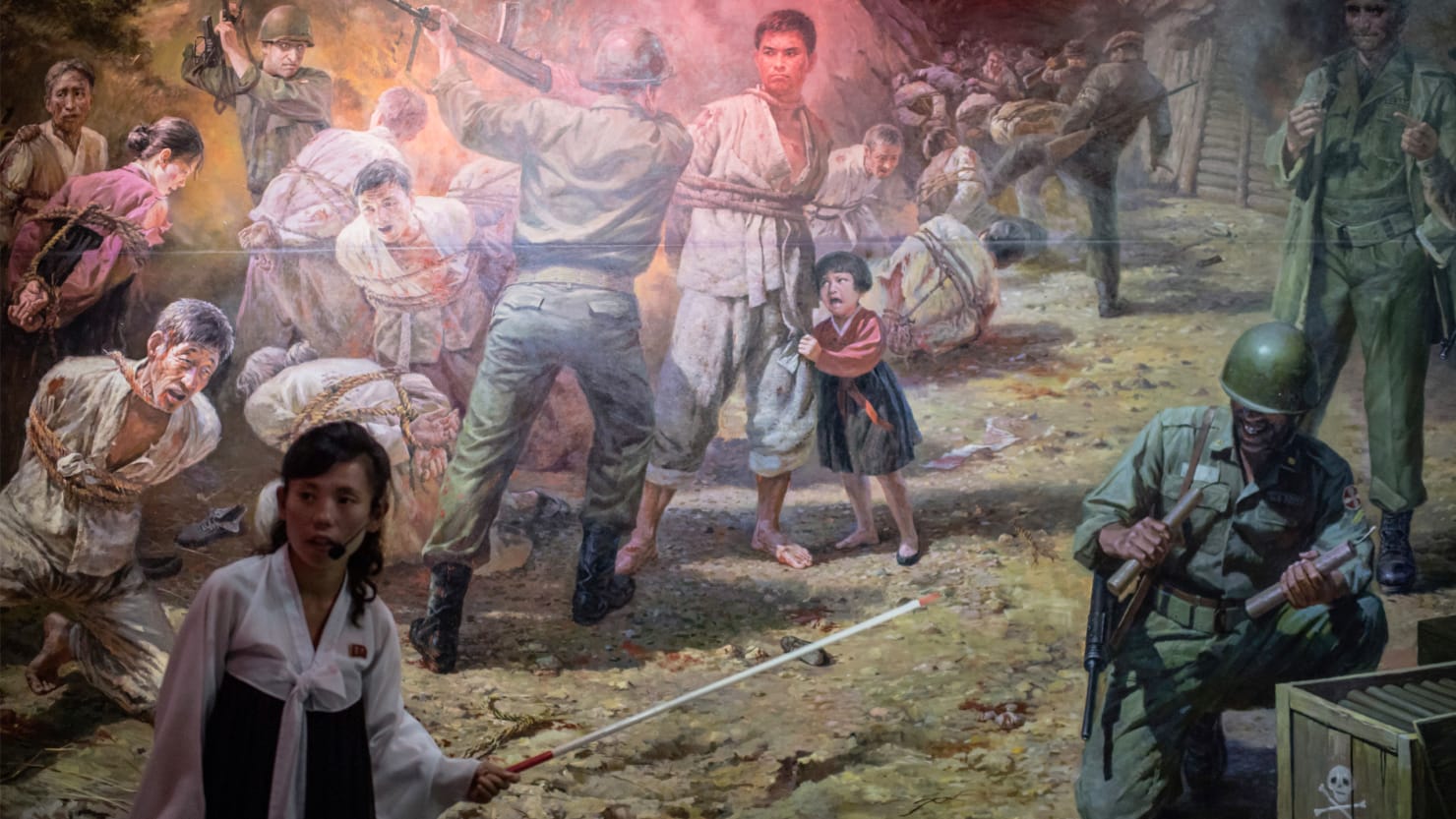Most people don’t know it is possible to travel to North Korea, but it is relatively easy. About 6000 tourists visit the country every year. Two guides and minders accompany you and you only hear a one-sided account of history. The nonstop propaganda reflects their belief that they live in the best country in the world – and this is one of the magic parts of the trip – we know they can’t leave or communicate with the outside world but they don’t.
It is a fascinating trip into another, unsettling world of complete police repression. North Korea’s human rights record is the worst on earth. Concentration camps, executions, state-orchestrated terror and mass control by a vast propaganda machine are a daily reality for millions here.
All the revenue from your trip goes directly to the government. Tourism is one of the few ways of encouraging openness in the DPRK, of letting people see that the West is interested, and more importantly friendly – not insignificant for a population brought up on a relentless diet of anti-US propaganda. Part of the fascination of travelling here is trying to divine the real from the fake and see past the ideology.
If you decide to come, the one thing you should never do is visit with the intent of stirring up trouble or making any protest – your guides and any North Koreans having contact with your group will suffer serious consequences – you’ll achieve nothing more than speedy deportation.
If you do come, listen to the version of history given to you by the guides, accept that this is their version and leave serious criticism until home.
Visas are necessary for everyone and are issued by the North Korean embassy in Beijing. Your tour company arranges visas. I only had to provide a colour scan of my passport and a passport photo. It is not possible to get a stamp on your passport.
Our tour was with Young Pioneer Tours, one of six companies offering tours to N Korea when I went in October 2014. There were 15 in our group – three flew and 12 were on the train.
Day 1 Oct 13
We boarded the train at Beijing Train Station at 5:30 pm, Oct 13 (my birthday) for the 23-hour trip to Pyongyang.
At about 7 am, we reached the border and had 2 hours to kill. Most of us walked down to the river to see N Korea from the China side. There is a big railway bridge and a road bridge bombed by the Americans in 1952, that only goes halfway across the river. The two sides are quite the contrast – China modern with many skyscrapers and the Korean side with no tall buildings and only one crane.
On the Korean side, we had another 2 hours when our luggage was inspected on the train. I chatted for a while with the soldier guarding our car. We were not allowed to step onto the siding so I stood in the doorway. His English was good and he asked me many questions. It was very pleasant. A few cars were driving in the distance but most people were walking.
After passing through Sinuju on the North Korean side, the scene changed remarkably. It was rice harvest season and the endless rice fields were full of people working hard. The main housing was one-story white houses in small villages and one small town with a few 4-story Soviet-style apartments. Every square inch of land is planted with vegetables filling all cultivable space not in rice. The wide plain was bordered by low, deforested mountains. There were no cars, the occasional motorcycle, a few heavy trucks involved in the harvest, bullock carts and everybody walking or on bicycles.
For our Korean guides (a young woman named Pak who does all the guiding and an older guy named Kim, who is the minder), we were to bring a gift (one carton of American cigarettes, alcohol, or candy) and plan on a tip of 7€/day or 28€ total as we are only in the country with them for four days. These were to be given at the end of the trip. By treating our guides well, more freedoms are allowed and each subsequent trip is dependent on the generosity of the group before. Buy the presents duty-free at the border. Out retinue was filled out by a tourism student (Bak, she was very shy and quiet), a videographer who was preparing a DVD of our trip (40 euros), and the driver. Our guides were employed by the KITC, the Korean International Travel Company, which deals with outside tour companies.
To simplify this post, I will refer to the three North Korean leaders as:
#1. Kim Il-sung (1912-1994, leader 1945-1994). Referred to as the President, a role held eternally.
#2. Kim Jong-il (-2011. Leader 1997-2011). Referred to as the Comrade. He is the eternal Chairman of the National General Assembly.
#3. Kim Jong-un (1983?- . Leader 2011- ). Referred to as the Marshall. He is the First Chairman of the General Assembly and First Secretary of the Korean Workers Party. He has two older brothers, both bypassed for leader. The oldest was found to trying to enter Japan illegally and now lives in Macao. The second is thought to be too effeminate to be an effective leader.
Kim Jung-un attended a private school in Switzerland incognito and loved basketball. His date of birth isn’t even known for sure, is believed to be between 1982 and 1984 making him the youngest national leader in the world today. His father never gave a speech in public, but he has given several and is seen attending events with his wife at his side (identified as Ri Sol-ju, a glamorous woman about whom very little is known). On assuming power, he unseated the staunchly conservative Ri Yong-ho, the head of the Korean People’s Army, and he was appointed head of the KPA, a key role in a country where the military holds so much power. We were reticent to ask what happened to Kim Jung-uns uncle who “disappeared” last summer. Wrestling control of the economy from the army will take time as there is no private enterprise and incredibly inefficient industries.
PYONGYANG (pop 3 million). This is another world best described as an ideological statement forged in concrete, bronze, and marble. Built almost entirely from scratch since its destruction in the Korean War, it is a big, superficially attractive city with grass, tree-lined boulevards and tall, modern-looking apartment buildings. Up close the buildings were shabby with old paint. Our guides boasted that they had no pollution but an obvious pall of smog overhung the city – not from cars as there are so few, but from the two huge, filthy, coal-fired power plants.
The Ryugyong Hotel dominates the skyline. Still under construction, it is 105 stories with five revolving restaurants. It is triangular and forms a steeple-like pyramid.

The orange twin-towered Koryo Hotel built in 1985 is also an impressive feature of the skyline. It has a revolving restaurant on top of each tower, but one has always been closed as it overlooks a sensitive area.
Our hotel is the Yanggakdo, a 47-floor building with 1,000 rooms, 2,000 beds and a revolving restaurant on the top. It is on the east tip of an island in the river.
After the large impressive lobby, the interior was a little tattered. Lights in the room were dim, there was only one plug-in, and the windows were on the small side. I needed my headlight to read. The TV had BBC. The shower took a while to get warm, blew more air than water, and turned cold quickly. After dinner in a restaurant in the hotel, we all headed down to the basement where the recreation facilities were. There were shops, a three-lane bowling alley, pool tables, table tennis, a swimming pool, massage, and karaoke, all with individual bars staffed by women and a fee for use. We all bowled (20 RMB per game) and drank beer.
One of the remarkable things about North Korea is the darkness – no streetlights, a few dim lights in the apartments from the low-wattage bulbs. It was not possible to go far outside the hotel. The walkway around the hotel skirting the water was fenced off.
We had breakfast three times in the hotel. Coffee was instant and served with Coffee-Mate.
The city itself is ancient dating back to the Goguryeo dynasty in 427. It was destroyed by the Japanese in 1592, the Manchus in the 17th century, the Japanese again in 1894-95 in the Sino-Japanese War, and finally by the Americans in 1950-53. Other than a few temples and sections of ancient walls, it is thoroughly modern.
Day 2 Oct 14
After a good sleep unaffected by traffic noise, this was the big sightseeing day in Pyongyang. The city is divided into East and West Pyongyang by the Taedong River.
Fountain Park. There were many water features and a large white statue of 28 dancers. Some bought flowers.
Mansudae Grand Monument. Statues of #1 and #2 – #2 had no statues of himself during his life so there has been a statue-building boom since he died in 2011. Both of them are everywhere – big smiling grins with always a view from the right as #1 had a large cyst on his neck. We stood in 2 rows, no hats or sunglasses, placed the flowers, and bowed (when in Rome….) to show respect.

Statues were flanked by two impressive statue monuments, one each to WWII (referred to here as the anti-Japanese War) and the Korean War (the anti-American War) with a big sheet of rock surrounded by soldiers and citizens joined in the fight.
Grand Peoples Study Hall. (The National Library) Children are not allowed here as they would be too noisy. Six floors had 30 million books and 6 million in foreign languages.
The huge hall on the bottom had 16 computers and 2 newspapers on stands – there were no chairs so all were standing. It was like a museum with some racks of old volumes and rows of desks with nifty knobs to raise the height of the desk and incline them, apparently an invention of #1. Very few people were in each hall.
At a lending counter on the second floor for foreign books, they showed several examples of the available material – ‘Open Hydraulics of Water’ (on water flow), ‘Encyclopedia of Chickens’, and some books on plants and animals.
We went into an English class half full of older students lining up to read English phrases with great difficulty. Comprehension appeared to be zero. The teacher made several mistakes in the readings and was very accented.
The Music Appreciation Room had old ghetto blasters and a few hundred DVDs – we listened to the Beatle’s “She Loved You”.
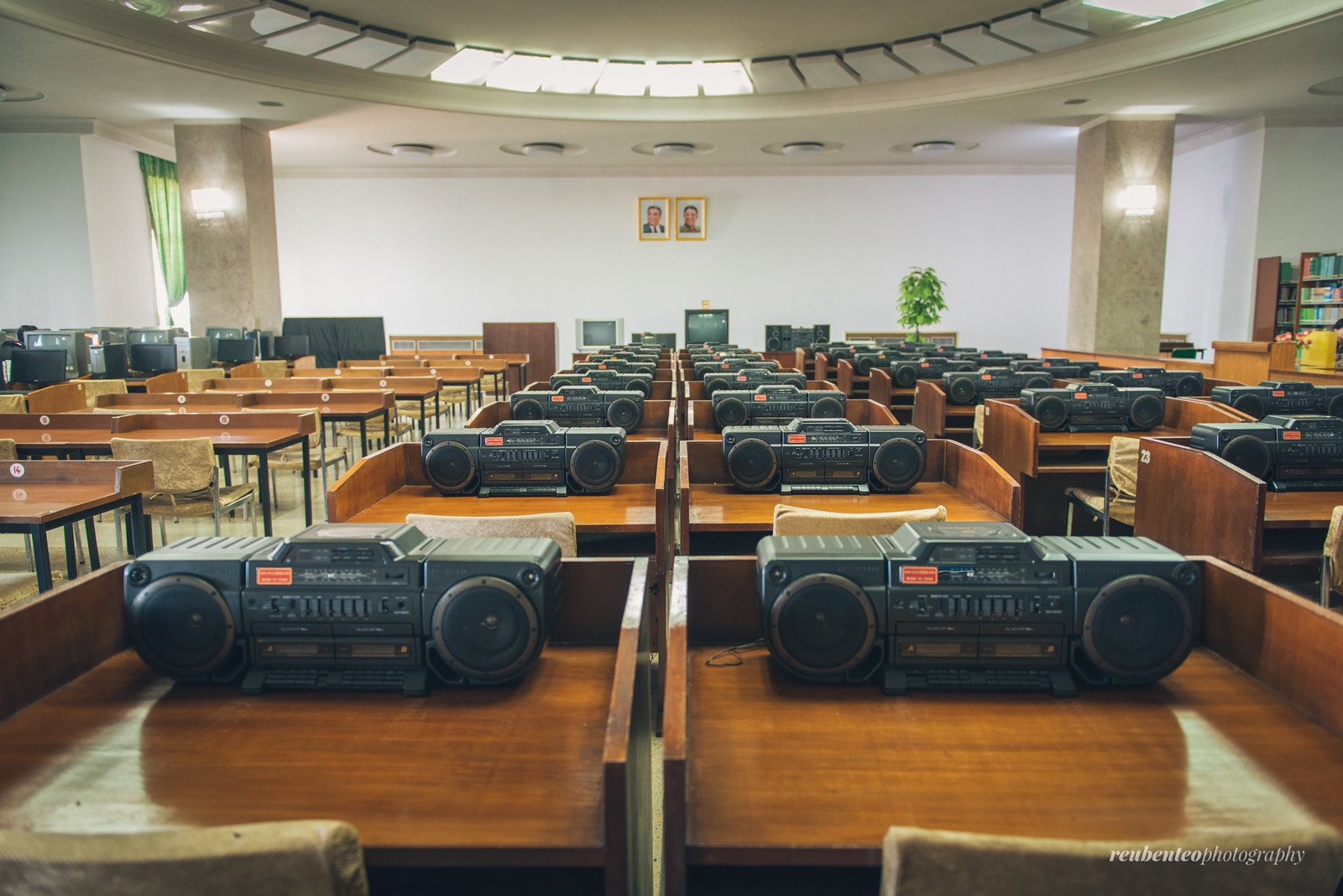
There was also a Movie Lending Library where you could pick up one of the many movies made in North Korea.
Kim Il-sung Square. This is the largest square in the country where all the marching parades are held. There were paint dots on the pavers to perfectly position the participants.
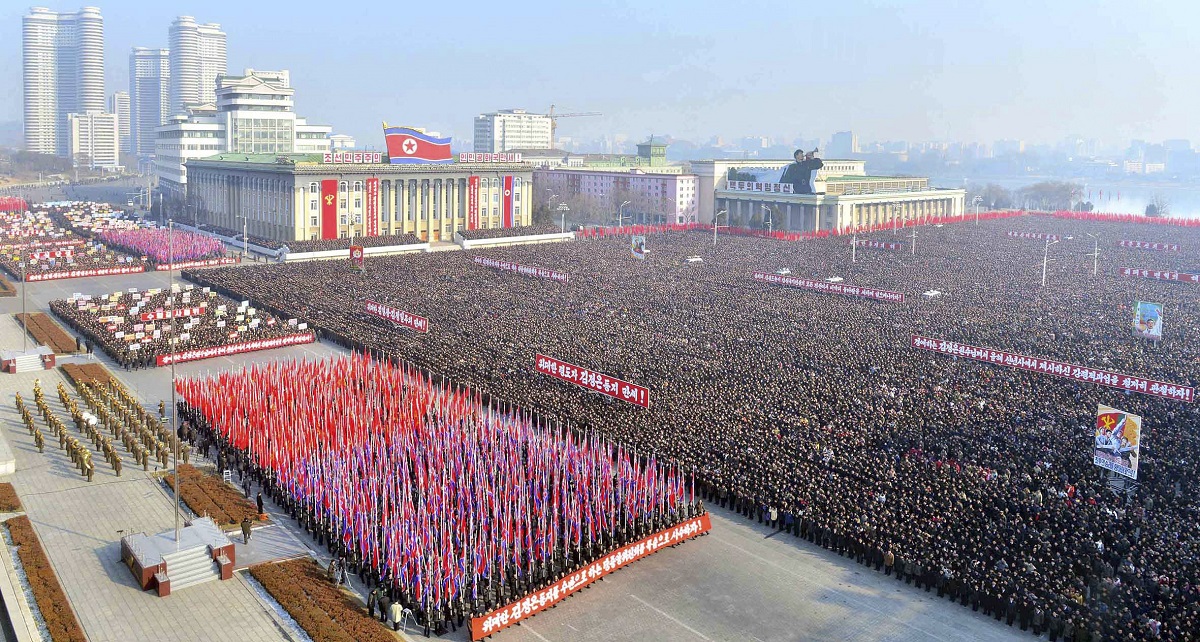
Foreign Language Bookstore – All books were North Korean propaganda, basically the works of the leaders and picture books of the country and souvenirs. It wasn’t possible to buy the red pins worn by all North Koreans on their chest. They must be applied for and given to those who have shown “loyalty” to the country.
In East Pyongyang, we saw:
Tower to the Juche Idea. Built in 1982, the 70th anniversary of #1”s birth, it is the highest stone tower in the world – 170m high with a 20m illuminated torch on a 150m tower, and 25,500 granite bricks (the number of days in 70 years). An elevator took us to the top for 4€ and grand city views. A river cruise ship was under construction on the river but stuck between two bridges about 500m apart. The Juche Idea is a philosophy that places man at the center of everything and it is man who determines outcomes through his actions. Plaques from study groups of the Juche Idea from countries were on the walls.
Party Founders Monument. These monuments had 3 elements and the symbols of the Korean Workers Party – a sickle (the farmer), a hammer (the worker), and a writing brush (the intellectual) commemorating the 1945 founding of the country and built in 1995, the 50th anniversary. Three large bas-relief bronze murals inside the round walls commemorated the victory over the Japanese – 100 battles, 100 victories – Ever Victorious.

Behind are two apartment buildings with a decreasing skyline representing fluttering flags. Between was a building with picture walls showing the accomplishments of the leaders. This was the only place we saw anything on #3. There are no statues of him.
Mansudae Art Studio. Korean art mostly paintings and ceramics for sale. We went to three studios, 2 artists and a family who had done pottery for several generations. To paint the leaders, artists need consent and approval of the final product. All show two smiling leaders facing to the right.
Pyongyang Metro. Built in 1972, it has two lines extending 35 km. We descended a very long escalator (timed at 2’ 48”, 42 seconds more than the longest in Moscow but maybe a little slower?), old people were sitting down on the escalator, and everybody looked us over carefully, especially the two tall Germans. They are deep enough to function as bomb shelters in the event of the long-awaited American invasion and have blast doors. Revolutionary music came from small speakers on the escalator.
The first station was “Prosperity” with 6 large copper bas reliefs flanking large mosaics (one to farmers and rural life, the other to industry) on each side of the platform, a large mosaic on one end to #1, and five coloured glass chandeliers. The cars were ancient from East Berlin.
The second station ‘Glory’, had magnificent 80 by 4-meter mosaics on each side of the platform (scenes of Pyongyang across the river and gorgeous flowered trees, birds, and flowers in the foreground), another large mosaic of #1, and marble columns with bronze rings.
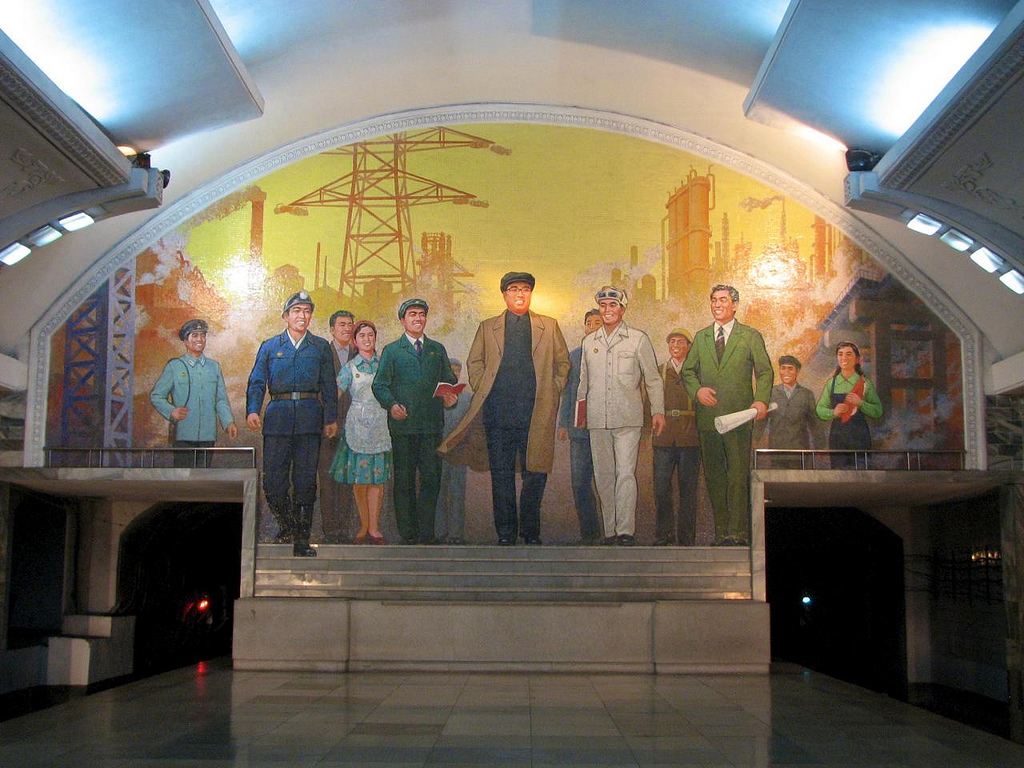
Newspaper stands were surrounded by readers squinting in the dim light.
Ragwon Department Store. We visited the supermarket to buy drinks, candy, and alcohol (there was snake ‘wine’ with real snakes). A one-pound bag of cashews costs $20 but most food is comparable to prices at home. The plan was to go to a bar but it was closed at 5 pm.
Victorious Fatherland Liberation War Museum and Memorial. Originally built in 1993 to commemorate the 40th anniversary of the end of the Korean War and totally rebuilt in 2012, it was impressive with grand exteriors, marble hallways, and exhibits built as dioramas. A long walkway was flanked on each side by five statue monuments of soldiers and outside that, displays of Korean (Merited Weapons Exhibition) and captured weapons including several planes and captured US helicopters from 1963 and 1994. The cannons were painted and in remarkable shape. A 27m tall Statue of Victory showed ‘Great Honor to the Great Years’.

The USS Pueblo was in the river. It was captured in 1968 after 17 espionage missions in North Korean waters. Only one of the 83 crew members died in the skirmish. A movie was shown in the mess hall and we toured the ship to see the letter of apology written by the US to gain the release of the prisoners eleven months later, plus letters from the crew members declaring that it was a spy mission. The ship is in remarkable shape and looks as if it is painted regularly.
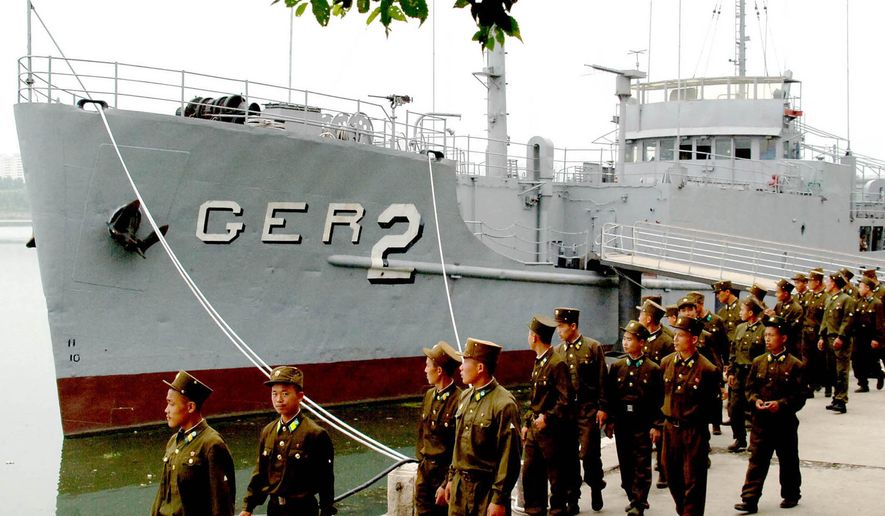
In the over-the-top museum, we were shown the film “Who Provoked the Korean War?” – a total rewrite of history blaming the entire event on the US. Our tour guide spieled off the facts in a very polished way. We went through an exhibit of a tunnel system with 12’ ceilings and winter camps. It was then a long walk through marble corridors to the Panorama room entered by stairs in the center.
We were surrounded by a 15m by 130m painting (40 artists took 1½ years to paint it) with scenes of a 1937 battle, and a 30m realistic foreground. The center rotated with special effects broadcast on the painting.

Day 3 Pyongyang.
Kumansen Palace of the Sun. This is the surreal mausoleum containing the embalmed corpses and museums of #1 and #2. It was stressed repeatedly how they had dedicated their entire lives to the people of Korea with behaviour that came deeply from their hearts. Originally built in 1994, it was named The Kim Il-sung Memorial Palace but was completely renovated in 2012 and the name changed. They had also added the honorific “Great Generalissmo’ to their multiple other titles. We were told that it was a sacred place, we had to be respectful and follow all the regulations.

We had been instructed to wear ‘formal dress’ to show respect to the great leaders. The grand buildings are surrounded by a moat and gardens with a busy crew of gardeners. After a wait in a large room, we queued four abreast, were checked off a list (the visits must be booked at least two weeks in advance), turned left, walked down a long roofed walkway, turned right, passed a cloakroom to deposit all but our money, went through security with thorough searches, went up an escalator and through automatic shoe cleaners, and stood on a slow, 250m long moving sidewalk, down an escalator, turned right, and another slow, 100m moving walkway flanked by 20 large, gold-framed pictures of #1 on the left and #2 on the right. Turning left, and up another escalator, we entered a long hallway with more pictures but this time of the two of them together. Turned right and entered an imposing 80m long room with nothing in it but two large white, marble statues at the one end.

The room was all marble with 10 marble columns on each side and 7 huge glass chandeliers. We bowed in front of the statues, turned right through more halls with pictures, down a big staircase and through an airlock with high-speed blowers and into the mausoleum of #1.
Lining up four abreast we bowed in front and on each of the sides, but not when standing behind the Great Leader’s head (I was next to Kim who bowed very deeply and long). Some of the Korean women were crying.
Then into the ‘museum’ with all his Korean medals (35) and awards – keys to cities, orders, honorary degrees, and certificates. We were rushed through, I think to prevent reading the meaningless details of the gift – all you could read was the name of the country but not the details. Few were from Western countries and most were from the ‘rogue’ states of the world.
The only letter from Britain was from the County Council of Derbyshire, a rural area with a national park and few people. The English guys conjectured that it was from a “loony lefty” with a little bit of power in the 60s. Honorary degrees are also often awarded by Student Unions of universities with a few radicals.
We then entered another big room with his Mercedes and a special train car that he toured North Korea – mostly a single room with gold brocade chairs lining the sides, a desk, a small room at the back for sleeping, and a toilet. On the wall was a large map of Korea that lit up all the routes he travelled in Korea (there aren’t many rail lines) and a world map showing his rail journeys and flights. His country count wasn’t very high.
It was then more halls, another airlock and the mausoleum of #2 with all the enforced bowing, another museum of honours (an amazing number from Ecuador), his identical Mercedes, railcar, and routes of his train journeys in Korea and his travels around the world (less than #1 as he was afraid of flying). There was also his large boat retired when he died.
We exited the same way along the slow escalators and moving walkways and pictures, collected our stuff, and walked around the gardens.
The place was packed with North Koreans dressed in their best – floor-length colourful gowns, suits, and ties or buttoned Communist jackets. Kim said they came with work groups from all over the country and were not Pyongyang people as they were tanned and their clothes often did not fit well or in the same style.
The mausoleum is open only till noon and not every day of the week, I believe, to keep the crowds large with a steady stream of kowtowing. I felt somewhat embarrassed to bow so much to these tyrants, but there was no doubt that it was mandatory. Besides all the guards, there were guys in suits examining our behaviour.
Revolutionary Martyr Cemetery. This monument to the anti-Japanese fighters was on top of the largest hill in the area. It consisted of 158 (12 women) gray stone bases (listing their name, birthdate, date they joined the army and date of death) with a likeness in a large bronze bust. Dates of birth ranged from 1905 to 1923. They were dressed in uniforms if in the army or civilian clothes if in the underground. In rows of 14, the very top had the most important fifteen including the wife of #1 who was born in 1917 and died in 1949. I asked Pak if #1 had a concubine after she died and received the most scornful look – I shrank into the ground.
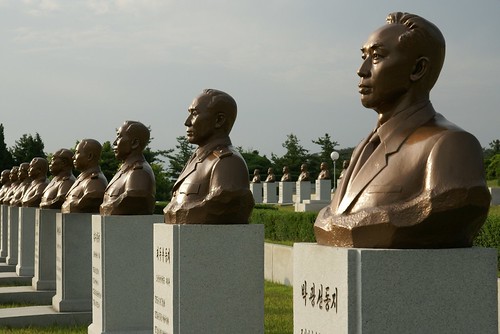
Our guides described the Japanese-dominated years of 1905-45 as “like a prison”, “miserable lives”, and no rights and how the Great Leader liberated the country, how he devoted his entire life to the country with all his heart, and how respected he is, even today. He certainly came along at an auspicious time in the history of North Korea.
Native Home of Kim Il-sung. This was his supposed birthplace and where he lived till 13 when his family went to China. It was also where he wrote the Constitution in 1945 when he was 33.
I got off the bus with a pop, lit a cigarette in the parking lot and walked to the “native home”. All hell broke loose. My cigarette and pop were taken. After the tour, Kim didn’t show up for 30 minutes. She arrived shaking as she had been severely chastised for my disrespectful behaviour.
The outbuildings and thatched home were heavily restored and isolated in a large park. The emphasis is on his humble origins. It is an open question whether he was born here at all. Our young guide asked me if I visited the native home of my leader very often. When I explained our political system, our large number of leaders and that I didn’t know where any of them were born, she seemed surprised.
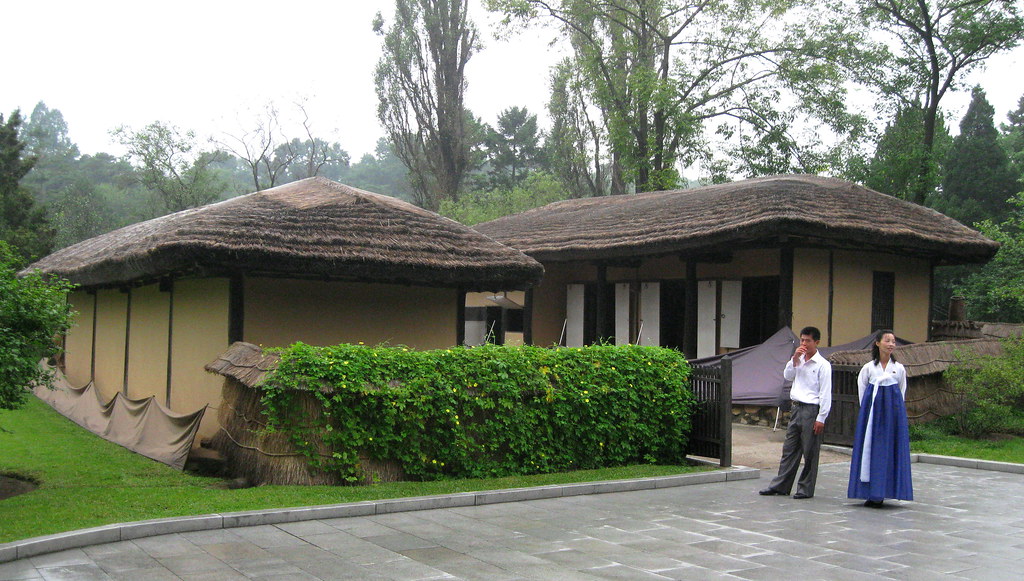
Sports Complex. With one building per activity and where the national teams practiced, we visited two shooting ranges. In one, it was possible to shoot live pheasants for 5€ per bullet.
Pyongyang Children’s School Palace. Children attend school here from 8-3 and extracurricular classes from 3-6 pm. We went to demonstrations of kids under 14 playing the gayagama (a traditional 18-stringed instrument with one end on the floor and the other on their laps), accordion, guitar, and piano – incredibly accomplished musicians playing with great emotion and skill.
Then there was a 40-minute world-class concert with singing, dancing, instrumentals, and an orchestra. It showed that these kids practiced 3 hours a day with superb instruction, and then performed frequently (daily on school days?). They had all the moves.
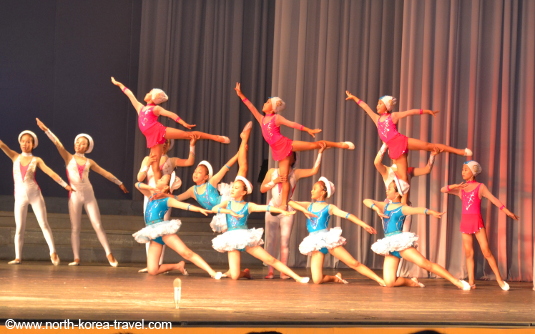
These performances can be seen on YouTube and a BBC documentary.
Children go to school for kindergarten, primary and middle school ending at grade 11. School (and work) here is 6 days/week with only Sundays off. It was stressed that school was completely free and compulsory. Gifted children go on to university or into the army. I wonder at the quality of education with the lack of computers, unknown qualifications of teachers, and the likely rote learning methods. Our young guide was surprised that Canada’s education and health care were ‘free’ and that school is compulsory for the same age. She was sure only N Korea offered such benefits.
We didn’t visit the 150,000-seat May Day Stadium, the largest in the world, as it was under renovation. As a result, we did not see the unforgettable Mass Games that took place nightly between August and October. More than 100,000 produced a dazzling display of coordinated political sloganizing, gymnastics, dance, music, and drama. The long-running Arirang Mass Games, the story of Korea’s history, was retired with the renovation in 2012. Prices were steep at 80€ for a third-class ticket and rising to 300€ for a VIP ticket. But the experience was supposedly worth every cent.
Food. We were treated to special meals in restaurants in the city – hot pot, BBQ, a duck BBQ, and the ‘kings meal. All consisted of multiple dishes with vegetables, salads, kimchee, soups, water, beer, and soju (a fermented rice drink that is 60 proof)
KAESONG (pop 320,000). In the late afternoon, we took the bus south on the Reunification Highway, 170 km and 3 hours to Kaesong. Ten minutes from our hotel in Pyongyang, we were in rural farmland, one of the most demarcated city outskirts in the world. On the drive down, we stopped for a brief break. Away from the lights of the bus, the sky was brilliant. I called my fellow travellers and pointed out the Milky Way. It was the first time they had ever seen it.
Kaesong is just 10 km north of the DMZ, the prime reason to visit here. The city escaped bombing in the Korean War as the UN forces thought that it would be captured and stay in the south. It has one of the world’s most concentrated build-ups of military forces. It is a designated Unesco World Heritage Site with twelve remains of the Goryeo dynasty.
It has an old town with traditional one-story houses. We stayed one night in the Kaesong Folk Cultural Hotel. The rooms were tatami rooms where we slept on the floor. The lights of Seoul, just 70km away cast a reddish glow to the southwest skyline.
Day 4
In the morning, the street outside was busy with bicycles but few vehicles. The few small creeks were strewn with garbage and women were washing clothes in the water. We were told to not take pictures of the people as they were very shy. The town is dominated by a massive statue of Kim Il-sung atop a high hill. We walked partway up for views of the city and then visited the Goryeo Museum, once a university.
DMZ. We then drove down the empty four-lane highway to the DMZ and waited in queue for an hour for our visit.
A North Korean flag sits on a 170m pole, 20m higher than the South Korean one. I asked the captain how big the flag was and he answered “Don’t ask me, you have internet, look it up”. He showed a map and accompanied us with two soldiers on the bus.
The first hundred meters of the walled road was flanked by an anti-tank system of huge blocks of concrete supported by small wood blocks that could be easily hammered out to completely block the road. Barbed wire fences and guard towers flanked the road. The town of Panmunjeom and 240 farming families live in the DMZ.
The DMZ is one of the most pristine landscapes in the world as it has remained completely unaltered since 1953. A stone slab had #1’s signature exactly as he signed it on July 7 1994 on a reunification document. He died a few hours later. They stressed how much #1 and the country wanted reunification.
We then entered the two-story building looking down on the seven low buildings, one of which is the conference room where all negotiations take place between the south and the north. For unknown reasons, we were not allowed to visit.
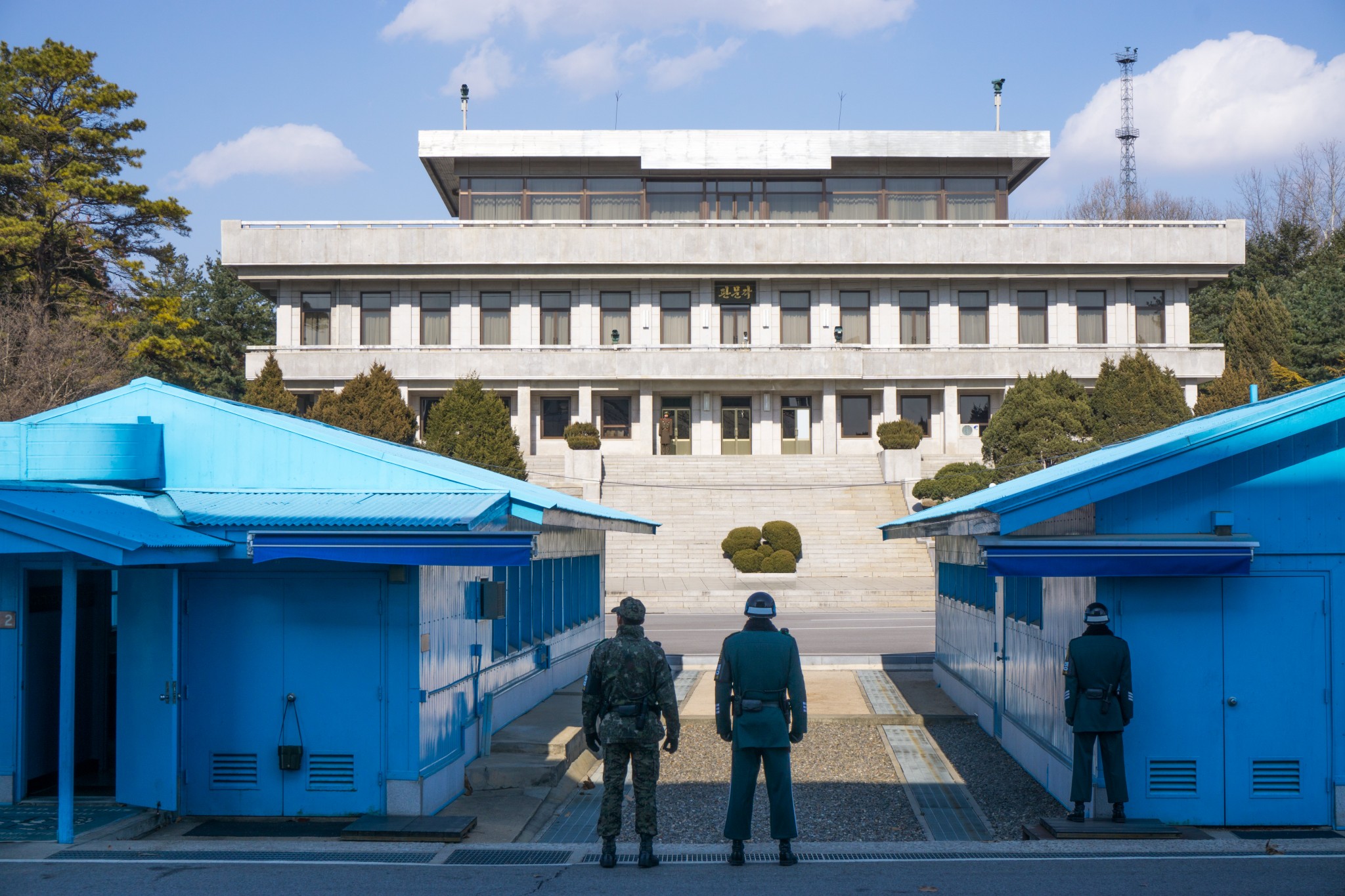
However, we took many pictures with the captain. Compared to the rigidness of the visit to the DMZ from the south, the atmosphere was quite relaxed. Our guide gave all the soldiers a pack of cigarettes. On our way back we stopped at the Armistice Talks Hall where negotiations were held between the two sides from 1951 until the final armistice, which was signed on July 27, 1953. There are two copies of the agreement and the original North Korean and UN flags. As I was taking notes frequently, the captain asked me several questions about what I thought of reunification and said that North Koreans want reunification as a federation with separate capitalist and socialist governments. “If the enemy forgets the past, then the Korean people will smash them”.
Outside a plaque in red script best sums up the North Korean version of the ceasefire. It reads:
It was here on July 27, 1953, that the American imperialists got down on their knees before the heroic Chosun people to sign the ceasefire for the war they had provoked on June 25, 1950.
After the DMZ, we drove back to Pyongyang during the daytime. It was startling. At night we rarely saw a light but in the daytime, we constantly passed small rural villages and the occasional big city. This is the darkest nation on earth. The four-lane divided road was heavily patched and rough.
We stopped in Sarirvon, an industrial town of 300,000. It was a dry area until 1960 when #1 suggested they build a lake and an irrigation ditch! Now textiles, cement, steel and machinery are the main products, but nobody saw any factories. We walked up to an overhanging observation deck with a view down to some artificial lakes full of weeds. Most of us rode a bicycle. Kim was very interested in what we thought of the made in N Korea bicycle and its excellent quality.
We were at the end of the workday and large groups were walking or riding bicycles along the road. Most carried spades. We saw fields of cotton, wheat, corn and grapes. Both wheat and rice were hand-threshed.
Just before Pyongyang we passed under the Reunification Monument. It is a striking stone granite edifice of two women holding hands and supporting a seal with the reunified Korea.
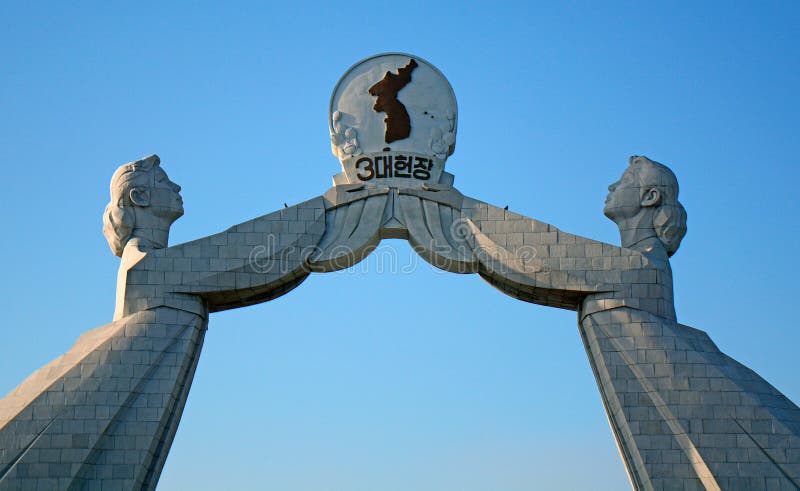
After dinner of BBQ duck in Pyongyang, we went to another amusement park with rides and then to the Diplomatic Club, a two-story, very posh place with karaoke, billiards, table tennis, and a swinging bar/restaurant full of Russians having a birthday party.
Day 5
Four of us took the train back to Beijing and the rest flew. It probably would have been worth the 40€ extra cost rather than repeat the somewhat boring 23-hour train ride with its 2-hour wait on each side of the border.
During the two-hour wait on the North Korean side of the border, our luggage was thoroughly checked. Photos on phones and cameras were also checked, more for curiosity than anything else.
